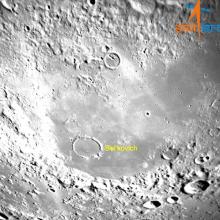Listen to today's episode of StarDate on the web the same day it airs in high-quality streaming audio without any extra ads or announcements. Choose a $8 one-month pass, or listen every day for a year for just $30.
You are here
Moon and Aldebaran
The Moon is bashful — it never shows us its backside. The same hemisphere always faces Earth. There’s a bit of a “wobble” that allows us to see around the edges a little. In all, though, two-fifths of the Moon is always hidden from view.
That part of the Moon is known as the back side, the far side, or the dark side.
People sometimes complain when it’s called the dark side. They argue that, over a cycle of phases, the near side and the far side receive equal amounts of sunlight. As a result, the far side is no darker than the side we always see. And they’re absolutely right.
The “dark-side” tag doesn’t refer to how much sunlight it gets, though. Instead, it refers to the fact that the far hemisphere is hidden from us. And until the Space Age, we had no idea what it looked like — it was completely unknown. It’s a lot like dark energy. It might not be dark, and it might not even be energy. For now, though, it remains unknown — a “dark” mystery for scientists to solve.
Today, of course, we know a lot about the dark side of the Moon. Orbiting spacecraft have mapped it in great detail. It has fewer dark volcanic plains than the near side, and lots more of the jumbled-up bright areas.
Most of the near side is in good view tonight — lit up by the Sun. And the bright star Aldebaran is close by. They wheel high across the sky during the night and set in the wee hours of the morning.
Tomorrow: Putting a leviathan to work.
Script by Damond Benningfield






